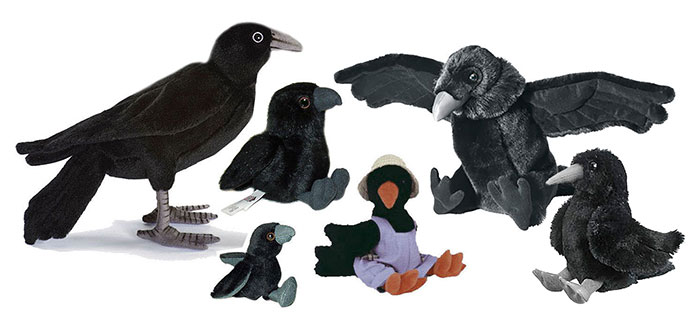


Find Ravens and Crows in the Aviary at Animals n More.
The plush toy black birds shown above include a Raven Cuddlekins from Wild Republic, a Crow from Hansa, a Crow keychain from the Stuffed Animal House, a Black Raven plush from the Stuffed Animal House, a Raven from Wildlife Artists and an Attic Treasure Crow named Cawley. Find Ravens and Crows at our sponsor's online gift shop.
There certainly is
nothing common about the Common Raven (Corvus corax). Extremely intelligent, these birds can be found in virtually all types of terrain: snow, deserts, forests, mountains and seaside. They are residents throughout the Northern Hemisphere.
This is a glossy black bird, similar to a crow but
larger (23 inches). The wingspan is four feet and the tail is wedge-shaped in flight. The bill, heavy and slightly hooked, is covered at the base with bristles, and the throat is covered with hackles (pointed feathers) giving the Raven a more rugged appearance. Their call is more of a croak than a caw.
Ravens remain paired for life and like to nest in tall trees or cliffs, their nest a large structure made of twigs and branches and lined with moss, grasses and fur. Three to seven spotted light-blue eggs are laid from February to May. The incubation period is about three weeks. Both parents tend the young. The young fledge in about five or six weeks. There is one brood per year. The fledglings will remain with their parents for approximately six months.
Ravens are omnivorous and eat a variety of offerings, including carrion, rodents, eggs, nestlings, insects, reptiles, berries, seeds and grains, including peanuts. When conditions are good, they will congregate in large roosts, some even numbering in the thousands.
Order: Passeriformes | Family: Corvidae | Species: Corvus corax



